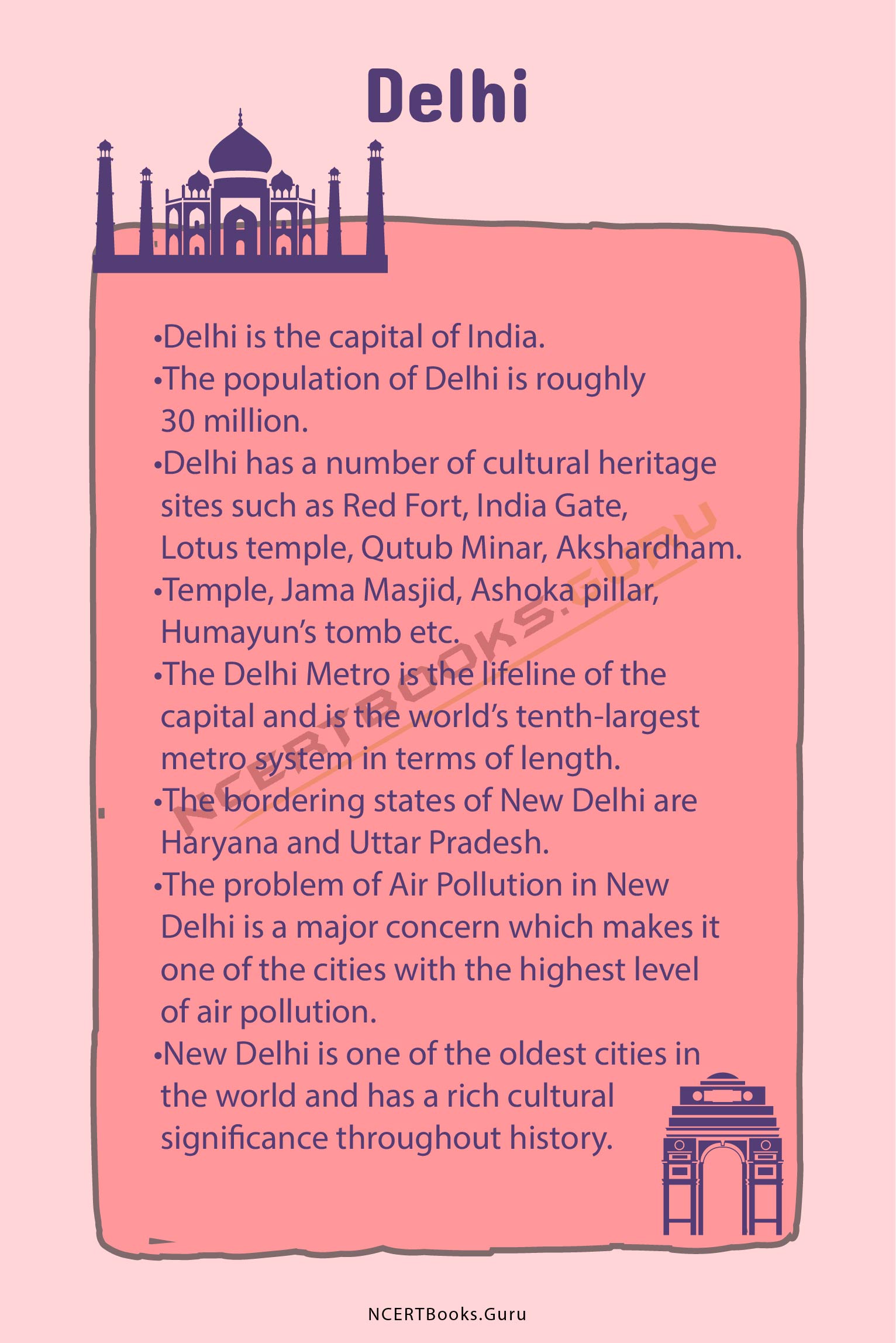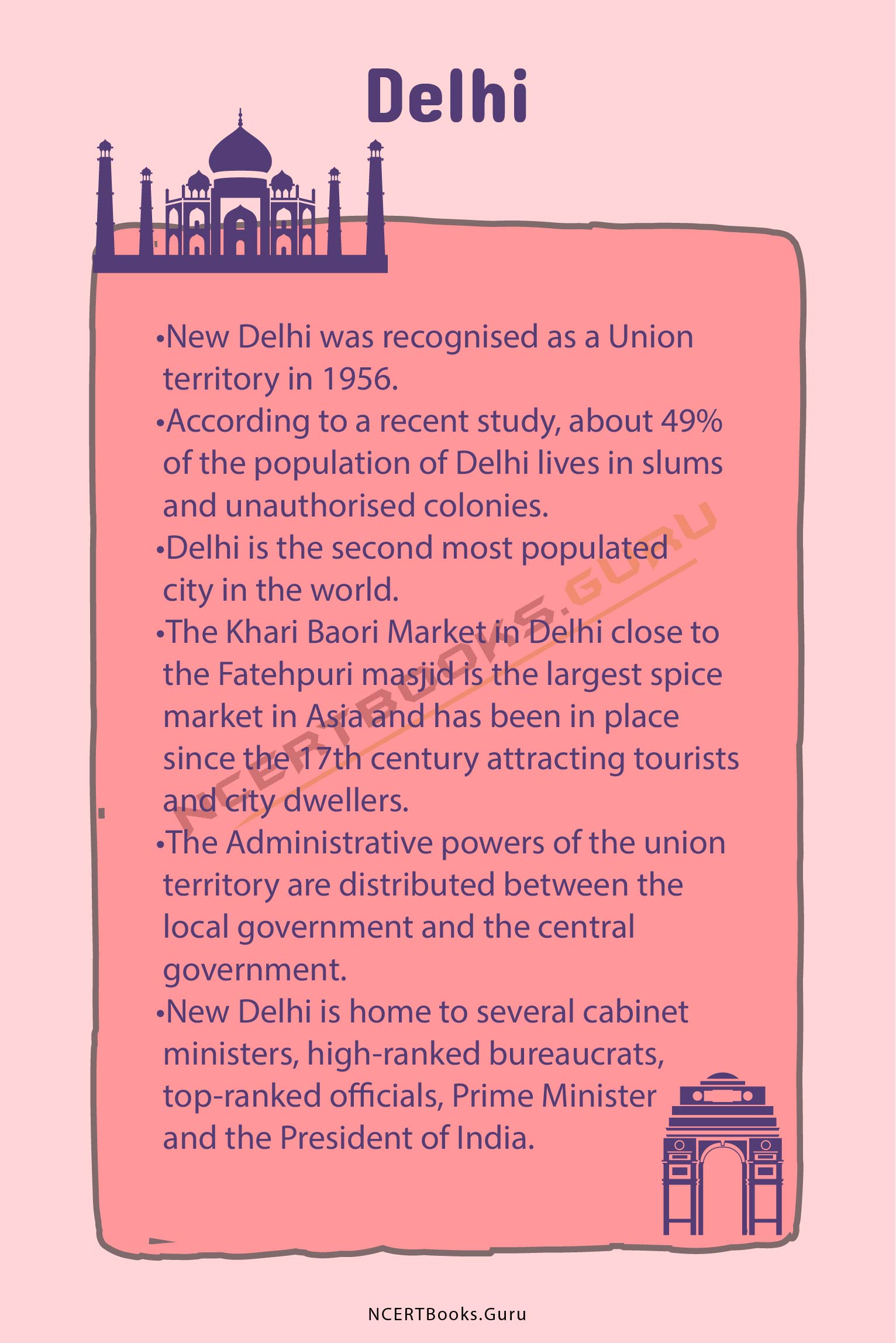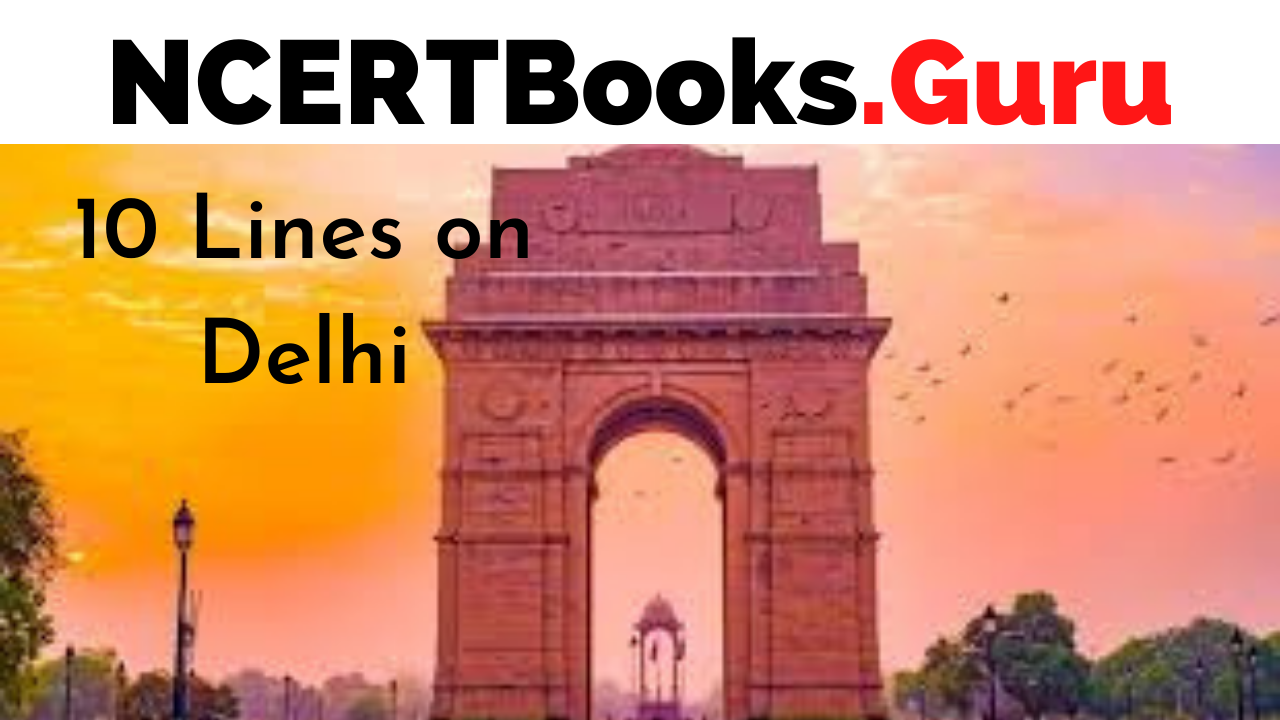10 Lines on Delhi: Delhi is the capital of India and was recognised as a Union territory in the year 1956. It was officially declared as the capital of India after the Independence in 1947. Delhi has been a place of historical importance since the beginning when the Pandavas ruled in the city, which was then called Indraprastha.
Delhi is presently the second wealthiest city of the country after Mumbai. The Delhi-NCR region includes the neighbouring cities of Gurgaon, Noida, Faridabad and Ghaziabad. Every year students and people of the working population come to Delhi in search of better opportunities. The city boasts some of the country’s finest universities and colleges.
Enhance your vocabulary and writing skills with 10 Lines Essays available. Spark up the creativity in you and access various Topics on 10 Lines all in one place.
Short Essay on Delhi
The NCT or National Capital Territory of Delhi is a city containing New Delhi, the capital of India. The city is bordered by Haryana on three sides and shares border with Uttar Pradesh on the eastern side. The total population of the city is roughly 30 million. The city is home to all the major bureaucrats and the high ranked government officials. The three arms of the government – the Legislative, the Executive and the Judiciary are located in the city.
Delhi also boasts some of the important cultural heritage sites of the country such as Red Fort, Qutub Minar, Humayun’s tomb, Jama Masjid, India Gate, Akshardham temple, Agrasen ki Baoli etc. The city is also home to the headquarters of almost all government agencies. Given below are sets of 10 lines about Delhi. Students or anyone can use this information in discovering more about the city.
Set 1 – 10 Lines on Delhi for kids
The first set is meant for the students of primary classes from 1-5. It gives basic information about the city.
- Delhi is the capital of India.
- The population of Delhi is roughly 30 million.
- Delhi has a number of cultural heritage sites such as Red Fort, India Gate, Lotus temple, Qutub Minar, Akshardham
- Temple, Jama Masjid, Ashoka pillar, Humayun’s tomb etc.
- The Delhi Metro is the lifeline of the capital and is the world’s tenth-largest metro system in terms of length.
- The bordering states of New Delhi are Haryana and Uttar Pradesh.
- The problem of Air Pollution in New Delhi is a major concern which makes it one of the cities with the highest level of air pollution.
- New Delhi is one of the oldest cities in the world and has a rich cultural significance throughout history.
- The Delhi- NCR region includes the cities of Noida, Ghaziabad, Faridabad and Gurgaon.
- Indira Gandhi International Airport is situated in New Delhi which serves as the aviation hub for the rest of northern India. The National Capital Territory covers an area of almost 1484 square kilometres.

Set 2 – 10 Lines on Delhi for School Children
The second set gives a detailed analysis of the city. This set is meant for the students of class 6-10.
- Delhi is home to almost all the ministers and high-ranked officials such as Prime Minister, President, Cabinet ministers, ambassadors.
- The Supreme Court, The Parliament House, Indian Army headquarters are some of the major institutions in Delhi.
- IIT Delhi is among the top IITs in the country.
- The present Chief Minister of Delhi is Shri Arvind Kejriwal and the Lt. Governor of Delhi is Shri Anil Baijal.
- Delhi University is one of the most prestigious universities in the country and every year lakhs of students apply for admission in colleges like Hindu College, Hansraj College, SRCC, St. Stephens, LSR, Gargi College, Shaheed Sukhdev College of Business Studies etc.
- The NCT or National Capital Territory of Delhi resembles a state with its own legislature, high court and a council of ministers.
- The administration powers in New Delhi are distributed between the central government and the local government of New Delhi.
- The city has been inhabited since the 6th century and has been home to different kingdoms in different periods.
- The city is bordered by Haryana on three sides and borders with Uttar Pradesh on the east side.
- The Delhi Transport Corporation and other public transport vehicles run entirely on Compressed Natural Gas.
Set 3 – 10 Lines on Delhi for Higher Class Students
The third set provides an in-depth picture of the city and about its history. The set is meant for senior secondary students and higher.
- New Delhi was recognised as a Union territory in 1956.
- The local civic administration in New Delhi is divided among five bodies- the North Delhi municipal corporation, the South Delhi municipal corporation, the New Delhi municipal corporation and the Delhi cantonment board.
- According to a recent study, about 49% of the population of Delhi lives in slums and unauthorised colonies.
- Delhi is the second most populated city in the world.
- The Khari Baori Market in Delhi close to the Fatehpuri masjid is the largest spice market in Asia and has been in place since the 17th century attracting tourists and city dwellers.
- The Administrative powers of the union territory are distributed between the local government and the central government.
- New Delhi is home to several cabinet ministers, high-ranked bureaucrats, top-ranked officials, the Prime Minister and the President of India.
- On Republic day every year, a large parade is organised from the Rashtrapati Bhawan to the India gate moving on the Rajpath.
- The city also has a rich cultural heritage and includes sites of cultural importance such as India Gate, Red Fort, Qutub Minar, Jama Masjid, Akshardham Temple, Humayun’s tomb etc.
- New Delhi is the seat of the three important arms of the government- the Legislative, the Executive and the Judiciary.

Frequently Asked Questions on Delhi
Question 1.
What are the main causes of air pollution in New Delhi?
Answer:
The toxic quality of air in New Delhi is the effect of several reasons.
- Stubble burning by the farmers of the neighbouring states of Punjab, Haryana and Uttar Pradesh.
- Vehicular pollution and traffic menace is a major contributing factor in the city which leads to the degradation of air quality and the formation of smog.
- The situations worsen in Winter season as the dust particles remain locked in the air due to stagnant winds.
- Over-population is yet another reason for the declining levels of air quality in the capital.
- Less investment in Public transport and public infrastructure leads to more traffic and hence more pollution.
- Industrial pollution and garbage dumps add to the degrading quality of air.
- Large-scale construction in the Delhi-NCR region increases the dust particles in the air.
Question 2.
Comment on the Delhi metro rail system.
Answer:
The Delhi Metro Rail Corporation is the nodal authority responsible for the metro system in the capital. The first corridor opened in 2002 from Shahdara to Tis Hazari. The present metro system is 389 kilometres long with a total of 285 stations. The rail system moves underground, elevated and on the ground level in different regions.
The Delhi Metro Rail Network has expanded to the neighbouring regions of Noida, Ghaziabad, Gurgaon, Faridabad, Bahadurgarh and Ballabhgarh. Apart from providing a reliable mode of the transport system to the people of the capital, the Delhi Metro Rail Corporation also works to reduce the amount of air pollution in the air. It reduces greenhouse emissions by 6.3 lakh tons every year and also has solar panels set up on the roofs of stations.
Question 3.
What are some of the heritage sites located in Delhi?
Answer:
New Delhi is home to several rich heritage sites of the world. Some of the well-recognised heritage sites are-
- Humayun’s Tomb- The heritage site sits on the banks of the river Yamuna and is an architectural marvel built during the Mughal period.
- Qutub Minar- The landmark sit built in the 13th century is the world’s tallest brick minaret. Qutub Minar attracts thousands of tourists every day being a UNESCO world heritage site.
- India Gate- The India gate is situated at the eastern end of the Rajpath and stands tall as a War memorial built-in 1921 in memory of the soldiers who laid down their lives in the First World War.
- Red Fort – The Red Fort or Lal Quila was the home of Mughals for a period of 200 years and was a place of hosting important ceremonies. Even today on Independence Day, the Prime Minister addresses the entire country from the Red Fort.
- Jama Masjid- Jama Masjid stands tall in the Old Delhi region built in the Mughal period by the emperor Shah Jahan.
Question 4.
Comment on the historical significance of New Delhi.
Answer:
The capital of the country has a rich and significant historical background and has been ruled by some of the most powerful emperors. The historical pieces of evidence trace back to the Mahabharata Period. The city was called Indraprastha where the Pandavas used to live.
The city has gone from being ruled by Hindu kings to Muslim emperors from one ruler to another. In 1803, the Britishers claimed control over the city and later shifted their capital from Calcutta to New Delhi in the year 1911. After the Independence of India, New Delhi was officially declared as the capital of the country.
